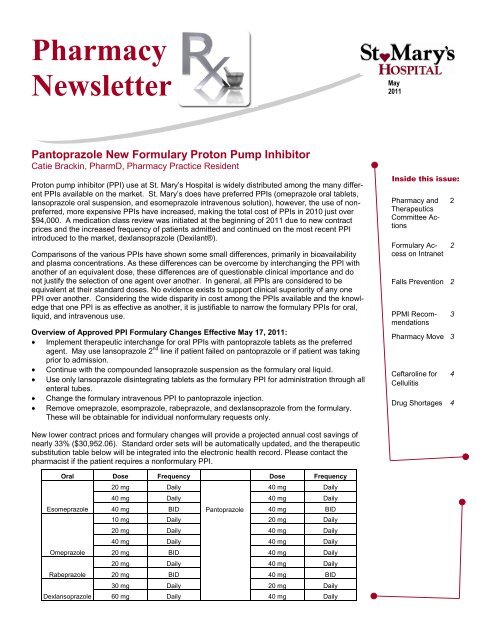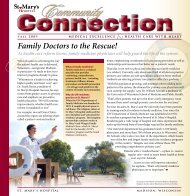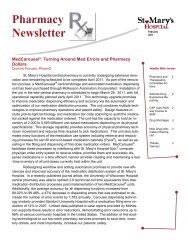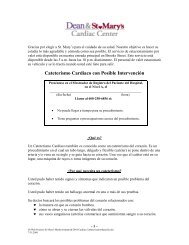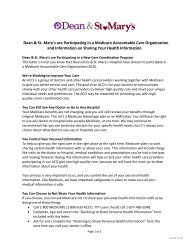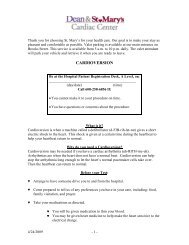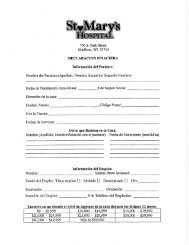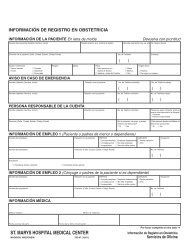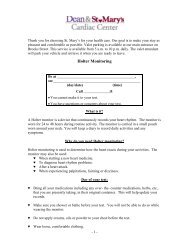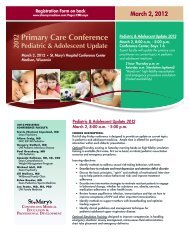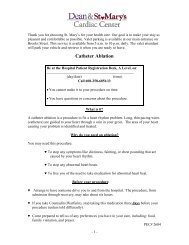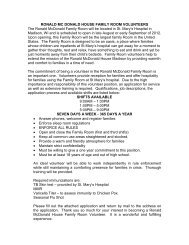link-Pharmacy Newsletter 052011 - St. Mary's Hospital
link-Pharmacy Newsletter 052011 - St. Mary's Hospital
link-Pharmacy Newsletter 052011 - St. Mary's Hospital
Create successful ePaper yourself
Turn your PDF publications into a flip-book with our unique Google optimized e-Paper software.
<strong>Pharmacy</strong><br />
<strong>Newsletter</strong><br />
May<br />
2011<br />
Pantoprazole New Formulary Proton Pump Inhibitor<br />
Catie Brackin, PharmD, <strong>Pharmacy</strong> Practice Resident<br />
Proton pump inhibitor (PPI) use at <strong>St</strong>. Mary’s <strong>Hospital</strong> is widely distributed among the many different<br />
PPIs available on the market. <strong>St</strong>. Mary’s does have preferred PPIs (omeprazole oral tablets,<br />
lansoprazole oral suspension, and esomeprazole intravenous solution), however, the use of nonpreferred,<br />
more expensive PPIs have increased, making the total cost of PPIs in 2010 just over<br />
$94,000. A medication class review was initiated at the beginning of 2011 due to new contract<br />
prices and the increased frequency of patients admitted and continued on the most recent PPI<br />
introduced to the market, dexlansoprazole (Dexilant®).<br />
Comparisons of the various PPIs have shown some small differences, primarily in bioavailability<br />
and plasma concentrations. As these differences can be overcome by interchanging the PPI with<br />
another of an equivalent dose, these differences are of questionable clinical importance and do<br />
not justify the selection of one agent over another. In general, all PPIs are considered to be<br />
equivalent at their standard doses. No evidence exists to support clinical superiority of any one<br />
PPI over another. Considering the wide disparity in cost among the PPIs available and the knowledge<br />
that one PPI is as effective as another, it is justifiable to narrow the formulary PPIs for oral,<br />
liquid, and intravenous use.<br />
Overview of Approved PPI Formulary Changes Effective May 17, 2011:<br />
Implement therapeutic interchange for oral PPIs with pantoprazole tablets as the preferred<br />
agent. May use lansoprazole 2 nd line if patient failed on pantoprazole or if patient was taking<br />
prior to admission.<br />
Continue with the compounded lansoprazole suspension as the formulary oral liquid.<br />
Use only lansoprazole disintegrating tablets as the formulary PPI for administration through all<br />
enteral tubes.<br />
Change the formulary intravenous PPI to pantoprazole injection.<br />
Remove omeprazole, esomprazole, rabeprazole, and dexlansoprazole from the formulary.<br />
These will be obtainable for individual nonformulary requests only.<br />
Inside this issue:<br />
<strong>Pharmacy</strong> and<br />
Therapeutics<br />
Committee Actions<br />
Formulary Access<br />
on Intranet<br />
2<br />
2<br />
Falls Prevention 2<br />
PPMI Recommendations<br />
3<br />
<strong>Pharmacy</strong> Move 3<br />
Ceftaroline for<br />
Cellulitis<br />
4<br />
Drug Shortages 4<br />
New lower contract prices and formulary changes will provide a projected annual cost savings of<br />
nearly 33% ($30,952.06). <strong>St</strong>andard order sets will be automatically updated, and the therapeutic<br />
substitution table below will be integrated into the electronic health record. Please contact the<br />
pharmacist if the patient requires a nonformulary PPI.<br />
Oral Dose Frequency Dose Frequency<br />
Esomeprazole<br />
Omeprazole<br />
Rabeprazole<br />
Dexlansoprazole<br />
20 mg Daily 40 mg Daily<br />
40 mg Daily 40 mg Daily<br />
40 mg BID Pantoprazole 40 mg BID<br />
10 mg Daily 20 mg Daily<br />
20 mg Daily 40 mg Daily<br />
40 mg Daily 40 mg Daily<br />
20 mg BID 40 mg Daily<br />
20 mg Daily 40 mg Daily<br />
20 mg BID 40 mg BID<br />
30 mg Daily 20 mg Daily<br />
60 mg Daily 40 mg Daily
<strong>Pharmacy</strong> and Therapeutics Committee Actions<br />
Kate Rotzenberg, PharmD<br />
From the March 23rd meeting:<br />
Formulary <strong>St</strong>atus Changes<br />
IV Acetaminophen (Ofirmev®) has<br />
been added to formulary at <strong>St</strong>.<br />
Mary’s <strong>Hospital</strong>. The full monograph<br />
is available on <strong>St</strong>. Mary’s Intranet<br />
through the <strong>Pharmacy</strong> <strong>link</strong>.<br />
Ceftaroline (Teflaro®) has been<br />
added to formulary at <strong>St</strong>. Mary’s <strong>Hospital</strong>,<br />
restricted to use by Infectious<br />
Disease. The full monograph is available<br />
on <strong>St</strong>. Mary’s Intranet through<br />
the <strong>Pharmacy</strong> <strong>link</strong>.<br />
Dabigatran (Pradaxa®) has been<br />
added to formulary at <strong>St</strong>. Mary’s <strong>Hospital</strong><br />
(Tier 2 Dean Health Plan). The<br />
full monograph is available on <strong>St</strong>.<br />
Mary’s Intranet through the <strong>Pharmacy</strong><br />
<strong>link</strong>. A 6 month medication use<br />
evaluation will be conducted on prescribing<br />
and outcomes and will be<br />
presented at the September meeting.<br />
Drug Class Reviews<br />
Proton Pump Inhibitor Review—<br />
Therapeutic interchange policy approved<br />
for pantoprazole, in effect<br />
May 2.<br />
Nasal <strong>St</strong>eroid Review—A therapeutic<br />
interchange is planned for the near<br />
future pending input from OB and<br />
ENT. This is a cost savings program<br />
similar to the Qvar® substitution implemented<br />
last year.<br />
Policy Changes<br />
Renal Dosing Policy updated for new<br />
additions to formulary and clarify use<br />
of high-dose piperacillin-tazobactam<br />
Best Practice Alert was approved for<br />
consideration of Hematology consult<br />
when IV direct thrombin inhibitors<br />
ordered<br />
New policy approved for timing of<br />
prophylactic enoxaparin to meet<br />
SCIP measures and accommodate<br />
planning invasive procedures. Order<br />
sets to be updated.<br />
Formulary Access on Intranet<br />
Kate Rotzenberg, PharmD<br />
A <strong>link</strong> to the formulary is now available on<br />
<strong>St</strong>. Mary’s Intranet below the <strong>Pharmacy</strong><br />
<strong>link</strong>. This document is an Excel spreadsheet<br />
arranged alphabetically by generic<br />
drug name and contains 1,970 entries<br />
based on inventory.<br />
Included information:<br />
Brand and generic drug name<br />
<strong>St</strong>rength<br />
Dosage form<br />
To search the list, use ctrl-F (hold down<br />
the Control key and type F) anywhere in<br />
the document. A box will appear and the<br />
user may search by any word contained<br />
in the document. Less is more—type<br />
only part of the drug name to avoid misspelling.<br />
This will take the user to the first<br />
entry that meets the search criteria, use<br />
the arrow for each subsequent entry.<br />
Non-formulary items, even if used frequently,<br />
are not on this list.<br />
Limitations of the current list:<br />
Reflects what the pharmacy orders,<br />
not necessarily what is prepared for<br />
patient use<br />
Does not identify drugs restricted to<br />
specific prescribing groups<br />
Cannot be grouped by drug class<br />
Does not identify cost differences<br />
Future versions of the formulary listing<br />
may incorporate some of this information.<br />
Fall Prevention: Helping Our Patients Walk the Line<br />
Randi <strong>St</strong>ouffer, PharmD, MPH, BCPS, CGP<br />
In 2002, the National Quality Forum declared<br />
that patient death or disability<br />
resulting from an in-hospital fall was a<br />
"serious reportable event." In 2008,<br />
Medicare stopped reimbursing hospitals<br />
for the care provided to treat<br />
the sequelae of such "never events," and<br />
other insurers quickly followed CMS's<br />
example. Given that a fall with injury<br />
increases a patient's length of stay by 12<br />
days, with over $4000 in increased costs<br />
(Bates et al., 1995), hospitals have increased<br />
their efforts to prevent patient<br />
falls. At <strong>St</strong> <strong>Mary's</strong>, our patients sustain<br />
more falls than the national average, but<br />
are less often injured. Regardless of<br />
injury, however, the cost per fall has been<br />
estimated at $351 (Boswell et al., 2001).<br />
The House-Wide Quality Improvement<br />
committee has introduced measures to<br />
reduce the fall rate, including interdisciplinary<br />
fall huddles (including pharmacists)<br />
after each patient fall on 4SW<br />
and 5SW. While initial results indicate<br />
that the fall huddles are creating a safer<br />
environment, evidence is still accumulating<br />
and the model is being fine-tuned<br />
before house-wide roll-out.<br />
The QI committee recognizes the demands<br />
upon pharmacists' time, especially<br />
during centralized hours, but the drugrelated<br />
information and advice have been<br />
valuable during fall huddles. It is hoped<br />
that the advent of patient acuity scoring<br />
will lead to a more proactive approach by<br />
pharmacists, allowing intervention before<br />
a fall occurs.<br />
Page 2<br />
<strong>Pharmacy</strong> <strong>Newsletter</strong>
<strong>Pharmacy</strong> Practice Model Initiative Recommendations: Current <strong>St</strong>atus<br />
Kate Rotzenberg, PharmD<br />
The American Society of Health-<br />
System Pharmacists held a <strong>Pharmacy</strong><br />
Practice Model Summit last November<br />
and recently issued their recommendations.<br />
The objectives of the <strong>Pharmacy</strong><br />
Practice Model Initiative are to:<br />
1. Create a framework for a pharmacy<br />
practice model that ensures<br />
provision of safe, effective, efficient,<br />
accountable, and evidencebased<br />
care for all hospital/health<br />
system patients;<br />
2. Determine patient care-related services<br />
that should be consistently<br />
provided by departments of pharmacy<br />
in hospitals and health systems<br />
and increase demand for<br />
pharmacy services by patients/caregivers,<br />
healthcare professionals,<br />
healthcare executives,<br />
and payers;<br />
3. Identify the available technologies<br />
to support implementation of the<br />
practice model, and identify emerging<br />
technologies that could impact<br />
the practice model;<br />
4. Support the optimal utilization and<br />
deployment of hospital and healthsystem<br />
pharmacy resources<br />
through development of a template<br />
for a practice model which is operational,<br />
practical, and measurable;<br />
and<br />
5. Identify specific actions pharmacy<br />
leaders and staff should take to<br />
implement practice model change<br />
including determination of the necessary<br />
staff (pharmacy leaders,<br />
pharmacists, and technicians) skills<br />
and competencies required to implement<br />
this model.<br />
<strong>St</strong>. Mary’s <strong>Pharmacy</strong> Department<br />
meets many of the recommendations<br />
from the summit through our current<br />
practice model. <strong>St</strong>. Mary’s pharmacists:<br />
are assigned to specific units<br />
based on patient acuity and/or census.<br />
participate in interdisciplinary patient<br />
rounds.<br />
review patient charts at the time of<br />
processing medication orders and<br />
daily for comprehensive review.<br />
dose selected medications for renal<br />
function and pharmacokinetic<br />
parameters per policy.<br />
document interventions in the<br />
medical record.<br />
undergo yearly competencies.<br />
participate in telepharmacy through<br />
after-hours review of medication<br />
orders at outside hospitals.<br />
As we push ourselves to exceed, some<br />
activities to pursue in the future may<br />
include:<br />
Establishing a patient medication<br />
complexity index for prioritization of<br />
patient review;<br />
Participation in discharge medication<br />
reconciliation and education;<br />
Establishing methods to track and<br />
trend pharmacist interventions;<br />
Establishing “tech-check-tech” distributive<br />
pharmacy functions.<br />
<strong>Pharmacy</strong> Moves into New Space<br />
Kate Rotzenberg, PharmD<br />
The Phase 1 construction is finally<br />
complete and the pharmacy staff have<br />
moved into their new space as of May<br />
2. The new pharmacy is located<br />
across from the current inpatient<br />
pharmacy behind the Northwest elevators<br />
on the B level.<br />
The <strong>Pharmacy</strong> Department held an<br />
Open House on Monday, April 25 for<br />
interested staff, providers and volunteers.<br />
The Phase 1 space consists<br />
of 5,304 square feet for the distributive<br />
pharmacy functions. The Phase<br />
2 space, anticipated to be complete<br />
in August 2012, will house the <strong>Pharmacy</strong><br />
offices, conference/break<br />
rooms, and staff support areas and<br />
consists of 2,521 square feet.<br />
The <strong>Pharmacy</strong> renovation includes<br />
the installation of the MedCarousel<br />
® —technology that utilizes barcode<br />
scanning when dispensing<br />
medications to reduce errors and provide<br />
efficient inventory.<br />
Other features include the new clean<br />
room, which is USP compliant<br />
and has a separate chemotherapy<br />
compounding room. The layout of<br />
the Phase 1 area is more efficient for<br />
the staff and provides an improved<br />
work environment.<br />
Contact information remains the<br />
same in the new pharmacy (x6551).<br />
Thank you to all the <strong>Pharmacy</strong> staff<br />
who volunteered during the Open<br />
House and the big move to make the<br />
transition as smooth as possible.<br />
Page 3<br />
<strong>Pharmacy</strong> <strong>Newsletter</strong>
<strong>Pharmacy</strong><br />
Editor: Kate Rotzenberg, PharmD<br />
Drug Information Pharmacist<br />
Katherine_Rotzenberg@ssmhc.com<br />
700 S. Park <strong>St</strong>.<br />
Madison, WI 53715<br />
Phone: 608-258-6551<br />
Fax: 608-258-5626<br />
Ceftaroline (Teflaro ® ) in Cellulitis Treatment<br />
Geri Naymick, PharmD, Antibiotic <strong>St</strong>ewardship Pharmacist<br />
Ceftaroline is an “advanced generation” cephalosporin recently<br />
approved by the FDA for skin and skin structure infections . It is<br />
similar to the first and second generation cephalosporins with<br />
activity toward gram positive (S. pneumoniae, MSSA, macrolide-resistant<br />
S. pyogenes, and S. agalactiae) and gram<br />
negative organisms (H. influenzae, E. coli, K. pneumoniae, K.<br />
oxytoca). Unlike other generation cephalosporins, ceftaroline<br />
has activity against MRSA, making it unique to the cephalosporin<br />
family. Its activity includes MSSA, CA-MRSA, vancomycin-intermediate<br />
(VISA) and vancomycin-resistant (VRSA) S.<br />
aureus. The MIC 90 for community or hospital acquired MRSA<br />
ranges from 0.25-1 mcg/ml. It does not cover pseudomonas,<br />
Enterococcus or ESBL producers.<br />
Ceftaroline appears to be an attractive antibiotic for cellulitis<br />
treatment. Besides its broad antibacterial spectrum for uncomplicated<br />
skin infections, there is a lack of drug interactions with<br />
a low side effect profile. However, it requires dosing every 12<br />
hours, a hindrance if outpatient treatment is considered. As an<br />
alternative, providing ceftaroline on an in-patient basis for initial<br />
therapy with transition to once-daily daptomycin in the outpatient<br />
ID Infusion Clinic would be a cost-effective measure.<br />
Daptomycin 500 mg vial costs approximately $230 compared to<br />
$84 for twice daily ceftaroline vials. Patient cost reflects a<br />
greater economic difference as daptomycin is dosed by weight<br />
and can average about $500-1,000.<br />
<strong>St</strong>atus of Drug Shortages<br />
Kate Rotzenberg, PharmD<br />
To gain clinical experience with ceftaroline, the Infectious Disease<br />
department would like ceftaroline to be ordered in patients<br />
with cellulitis with a suspicion of MRSA. Infectious Disease<br />
department must be consulted for facilitation of discharge to the<br />
infusion clinic. Ceftaroline is dosed 600 mg every 12 hours;<br />
pharmacy will adjust for decreased renal function. Crossreactivity<br />
with other beta-lactams (penicillins, cephalosporins,<br />
carbapenems) is established.<br />
Reference: Medical Letter Jan 2011<br />
Page 4<br />
Adult amino acids (Clinisol®)<br />
shortage is resolved.<br />
Clevidipine (Cleviprex®) became<br />
available in mid-April on a limited<br />
basis (50mL only) .<br />
Diltiazem injection shortage is resolved.<br />
Erythromycin injection is currently<br />
on back order, none is available for<br />
use at this time.<br />
Hyaluronidase injection continues to<br />
be unavailable. For medications that<br />
extravasate, continue to use the Extravasation<br />
Policy on the intranet and<br />
follow all steps without hyaluronidase.<br />
Ibuprofen lysine (Neoprofen®) is<br />
on back order. Indomethacin injection<br />
is being used as an alternative<br />
for PDA closure in neonates.<br />
Lorazepam (Ativan®) bulk vial for<br />
injection is now available for compounding<br />
infusions, shortage is resolved.<br />
Norepinephrine (Levophed®) injection<br />
shortage has been resolved.<br />
Propofol (Diprivan®) continues to<br />
be in nationwide shortage. Manufacturers<br />
continue to work with the FDA,<br />
but cannot confirm a date when the<br />
shortage will be resolved. At this<br />
time, the pharmacy has been able to<br />
maintain a supply of propofol.<br />
Vitamin A injection remains on back<br />
order.<br />
Please consult with your pharmacist if you<br />
have any questions related to drug shortages.<br />
<strong>Pharmacy</strong> <strong>Newsletter</strong>


